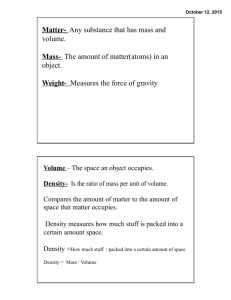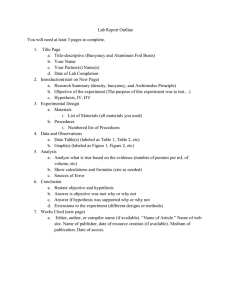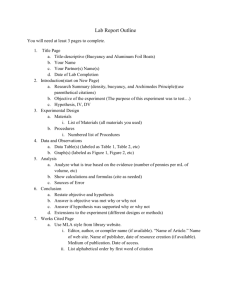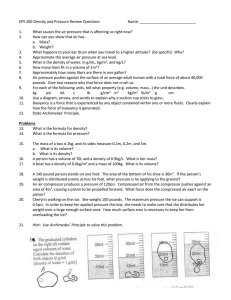Atmospheric Dynamics
advertisement
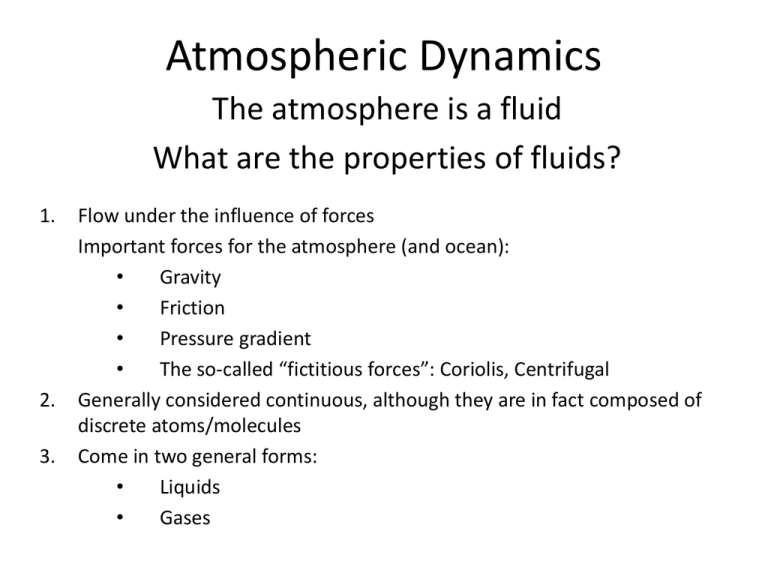
Atmospheric Dynamics The atmosphere is a fluid What are the properties of fluids? 1. 2. 3. Flow under the influence of forces Important forces for the atmosphere (and ocean): • Gravity • Friction • Pressure gradient • The so-called “fictitious forces”: Coriolis, Centrifugal Generally considered continuous, although they are in fact composed of discrete atoms/molecules Come in two general forms: • Liquids • Gases Forces and Motions Gravity – “heavy” fluid sinks / “light” fluid rises Example: buoyancy, like in a lava lamp – “BLOOP… BLOOP…” Friction – drag force acting on the fluid on account of its coming in contact with a rigid surface Example: excess drag on one side of a spinning baseball causes a net force (in this case, on the ball) in that direction – “STRIKE ONE!” Pressure Gradient – motion ensues from high-pressure to low-pressure under this force Example: fill your hose, set it on the ground, step on one end: what happens? Under your foot is high pressure, at the open end the pressure is low – “SQUIRT!” Forces and Motions FICTICIOUS FORCES Centrifugal Force – if you wish to move in a circle, you must overcome your inertia, i.e. your tendency to move in straight lines unless you are acted on by a force Example: sharp left turn in your car – “WHOA!” Coriolis Force – motion relative to a rotating surface is apparently affected by this force Example: rather like playing catch on a merry-go-round – “SMACK!” Forces and Motions Newton’s Second Law: v v v Fi Fnet ma i In words, a net force acting on an object causes it to accelerate by an amount proportional to the sum of forces and inversely proportional to its mass. If the net force acting on an object is zero, the object will move in a straight line at constant speed (Newton’s First Law). Density, Pressure and Temperature Density Mass per unit volume m V mks units: kg m-3 – “kilograms per cubic meter” cgs units: g cm-3 – “grams per cubic centimeter” Density, Pressure and Temperature Pressure Force per unit area F p A mks units: kg s-2 m-1 – Pa “Pascals” other units: bar, mb, atm, hPa Density, Pressure and Temperature Temperature (and the Ideal Gas Law) Temperature: Average kinetic energy of molecules units: Kelvins (K), degrees Celcius (oC) pV mRT p: pressure exerted by vapor V : volume occupied by vapor m : mass of vapor R: specific gas constant of substance T : temperature of vapor (must be in K) Density, Pressure and Temperature Use definition of density to formulate yet another version of the Ideal Gas Law p RT p : pressure exerted by the vapor : density of the vapor R : specific gas constant of the substance T : temperature of the vapor Buoyancy Archimedes' principle Vitruvius (De architectura IX.9–12) recounts the famous story of Archimedes making this discovery while in the bath. He was given the task of finding out if a goldsmith, who worked for the king, was carefully replacing the king's gold with silver. While doing this Archimedes decided he should take a break so went to take a bath. While entering the bath he noticed that when he placed his legs in, water spilled over the edge. Struck by a moment of realisation, he shouted "Eureka!" He informed the king that there was a way to positively tell if the smith was cheating him. Knowing that gold has a higher density than silver, he placed the king's crown and a gold crown of equal weight into a pool. Since the king's crown caused more water to overflow, it was, therefore, less dense, Archimedes concluded that it contained silver, causing the smith to be executed. The actual record of Archimedes' discoveries appears in his two-volume work, On Floating Bodies. source: http://en.wikipedia.org/wiki/Buoyancy Buoyancy Archimedes' principle Buoyancy Force = weight of the displaced fluid Weight: force of gravity Fg mg Example Problem: The volume of a lake freighter hull is V = 300 m X 30 m X 20 m = 1.8 x 105 m3. If the density of lake water is 1000 kg m-3, what is the buoyancy force acting on the ship if it is nearly submerged (i.e. the water line is at the deck)? What is the cargo capacity, assuming the mass of the ship is negligible compared to the mass of the cargo it is carrying (this is probably a fairly bad assumption)? Solution: The mass of displaced water is 1.8 x 108 kg and the weight of this water is then about 1.8 x 109 N. Thus, the buoyancy force acting on the ship will be about 2 billion Newtons. The cargo capacity would be somewhat less than 1.8 x 108 kg, depending on exactly how massive the empty ship itself is. How does buoyancy affect motion in fluids? ambient fluid parcel V 2 1 Will the parcel rise, fall or remain still? How does buoyancy affect motion in fluids? Forces acting on the parcel: 1. Gravity 2. Buoyancy FB 2Vg V Fg 1Vg Apply Newton’s Second Law: F ma i i FB Fg 1Va 2Vg 1Vg 1Va 2 1 a g 1 So, if the parcel is more dense than the ambient fluid (1 2), it will sink. Examples: ocean convection/deep water formation However, if the parcel is less dense than the environment ( 2 1), it will rise. Examples: hot air balloons, dirigibles, moist air in atmospheric convection How is buoyancy generated in the atmosphere? There are two main ways that buoyancy (and therefore motion) is generated in the atmosphere: 1. Add/Subtract moisture, since H2O has a lower molecular weight than dry air composed of N2, O2 and Ar 2. Increase/Decrease temperature (or a combination of the two, of course) Global Energy Budget (revisited) Atmospheric Motion The Tropics: The Hadley Circulation Atmospheric Motion The Tropics: Precipitation Patterns Atmospheric Motion The Tropics: Precipitation Patterns (Seasonal Cycle in Soil Moisture) http://geography.uoregon.edu/envchange/clim_animations/animated%20gifs/soilwo_web.gif Why do we have jet streams? Angular Momentum Conservation v L v v r v m angular momentum per unit mass distance to rotation axis east-west wind speed Figure Skater Atmosphere Atmospheric Motion The Extra-tropics: The Jet Streams Atmospheric Motion The Hadley Cell and Angular Momentum Schematic of the General Circulation What is weather? Midlatitude weather systems are instabilities of the zonal jet. A perfectly symmetric jet is unstable and begins to “meander”, producing mobile high and low pressure systems. Weather is the response of the fluid atmosphere to a local imbalance in the energy budget. The meandering jet stream What is weather? Midlatitude weather systems are instabilities of the zonal jet. A perfectly symmetric jet is unstable and begins to “meander”, producing mobile high and low pressure systems. Weather is the response of the fluid atmosphere to a local imbalance in the energy budget. Global Energy Budget (revisited) The function of large-scale atmospheric motions, including “weather” phenomena, is to transport thermal energy from the equator to the poles, thereby balancing the GLOBAL ENERGY BUDGET. Moving warm air to the poles and cold air to the tropics… Global Energy Budget Balanced global energy budget comprises radiative energy input and output as well as 1.Sensible heat transport (temperature) 2.Latent heat transport (water vapor) We just spent some time on the sensible heat budget; let’s look at water vapor transport… The Hydrological Cycle The Hydrological Cycle The Hydrological Cycle The Hydrological Cycle How in the world does evaporation and precipitation constitute heat transport in the atmosphere?!? 1. dump some radiative energy into tropical ocean surface and evaporate water – the energy is not used to heat the ocean but to evaporate the water 2. move the newly evaporated water vapor toward the poles in atmospheric circulations 3. condense the water vapor in extra-tropical clouds/rain – energy released by condensation warms extra-tropical air Net Result: Radiative energy deposited in the tropics has been used to warm extra-tropical air!


